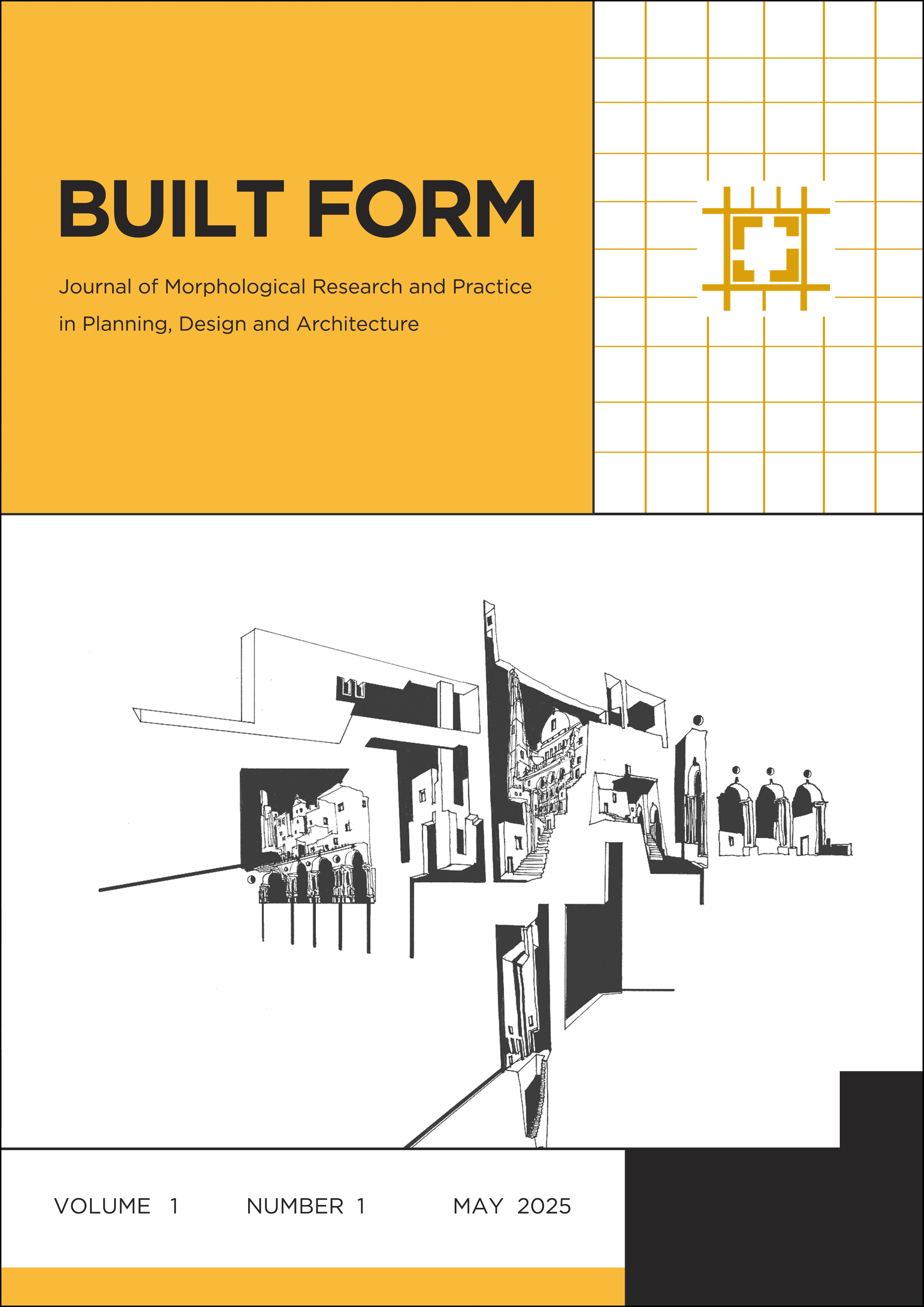Transformation, Connectivity and Accessibility Analysis of Elazığ’s Urban Squares
DOI:
https://doi.org/10.63955/BuiltForm.08Keywords:
urban square, spatial analysis, accessibility, connectivity, ElazığAbstract
Urban squares are significant public spaces utilized by city dwellers for social, cultural, political, and commercial purposes, in short, they are central venues for urban life. City users frequently prefer urban squares to carry out recreational activities. Within the process of urbanization, the most intensively used urban spaces are squares and the main streets associated with them. Streets that provide access to these squares, along with the squares themselves, serve as carriers of the social memory accumulated throughout a city's historical development, while also forming the core of urban life as elements of cultural heritage. Furthermore, urban squares stand out as key areas that reflect urban identity and play an important role in shaping the city’s image. This study aims to analyze the historical development, spatial transformation, urban context, and accessibility levels of 15 Temmuz Demokrasi Square and Republic Square located in the city centre of Elazığ. The physical and functional transformations these squares have undergone from past to present are evaluated with their impacts on urban memory and social life. Within the scope of spatial analysis, the positions of the squares in the street hierarchy, along with their local and global integration levels, are examined. In the accessibility analysis, service areas at the neighbourhood scale are determined based on walking distances.
References
Akman, K. (2020). Kent meydanlarının önemi ve değişen işlevi. Akademik Düşünce Dergisi, (1), 17–33.
Bayramoğlu, E., & Yurdakul, N. (2019). Kentsel açık mekân olarak meydanların yaşam kalitesine etkileri: Trabzon örneği. Journal of History Culture and Art Research, 8(1), 425–435. https://doi.org/10.7596/taksad.v8i1.1863
Carmona, M., Tiesdell, S., Heath, T., & Oc, T. (2010). Public places, urban spaces: The dimensions of urban design (2nd ed.). Routledge.
Cuthbert, A. R. (2006). The form of cities: Political economy and urban design. Wiley-Blackwell.
Czerkaue-Yamu, C. (2010). Space syntax: Theories and methods. In M. Helbich, J. Jokar Arsanjani, & M. Leitner (Eds.), Computational approaches for urban environments (pp. 99–113). Springer. https://doi.org/10.1007/978-3-642-03515-6_6
Çil, E. (2006). Bir kent okuma aracı olarak mekân dizim analizinin kuramsal ve yöntemsel tartışması. Megaron - YTÜ Mimarlık Fakültesi E-Dergisi, 1(4), 218–233.
Çil, E. (2006). Space syntax yönteminin kentsel mekân analizlerinde kullanımı. İTÜ Dergisi A, 5(2), 75–85.
Gehl, J. (2011). Life between buildings: Using public space. Island Press.
Gümüş, A., & Çiftçi, Ş. (2023). Coğrafi bilgi sistemleri ile erişilebilirlik analizi: Kentsel açık alanlara ulaşılabilirliğin belirlenmesi. Planlama Dergisi, 33(1), 55–70.
Gündoğdu, İ. (2014). Mekânsal analiz teknikleriyle kentsel açık alanların değerlendirilmesi [Master Thesis, Istanbul Technical University].
Hillier, B., & Hanson, J. (1984). The social logic of space. Cambridge University Press.
Kaya, A. Y. (2024). Kentsel yeşil alanların yeterliliği ve erişilebilirliğinin değerlendirilmesi: Tarsus (Mersin) örneği. Türk Uzaktan Algılama ve CBS Dergisi, 5(2), 222–239.
Kaya, H. (2024). CBS tabanlı ulaşım analizlerinde network hizmet alanı yöntemi. Coğrafi Bilgi Sistemleri ve Kentleşme, 4(1), 89–104.
Kayalar, J. (2006). Kent ve meydan olgusu – yeniden canlandırma sürecinde karşılaştırmalı bir irdeleme: Trafalgar Meydanı ve Eminönü Meydanı [Master Thesis, Mimar SinanFine Arts University].
Lynch, K. (1960). The image of the city. MIT Press.
Madanipour, A. (2003). Public and private spaces of the city. Routledge.
Özdemir, M., & Yolcu, E. (2023). Network analizi ile kamusal hizmetlere erişim: Yürünebilirlik temelli bir yaklaşım. Kent Araştırmaları Dergisi, 11(2), 21–38.
Seydioğulları, H. S. (2018). Kent kimliğinin kent meydanlarına yansıması: Alanya İskele-Rıhtım bölgesi örneği [Master Thesis, Süleyman Demirel University].
Şıkoğlu, E. (2022). Keban (Elazığ) cadde sokak sistemlerinin mekân dizim analizi yöntemiyle incelenmesi. Coğrafi Bilimler Dergisi, 20(2), 450–474.
Şıkoğlu, E., & Arslan, H. (2015). Mekân dizim analizi yöntemi ve bunun coğrafi çalışmalarda kullanılabilirliği. Türk Coğrafya Dergisi, (65), 11–22.
Taşçı, H. (2012). Kent meydanı ile kent kimliği ilişkisi: Üsküdar meydanı örneği (PhD Thesis, Marmara University, Social Science Institute).
Tiesdell, S., & Oc, T. (1998). Urban design: Ornament and decoration. Architectural Press.
Türk, H., & Oral, M. (2022). Sivas tarihi kent meydanının mimari ve mekânsal bağlamda mekân dizimi yöntemi ile analiz edilmesi. Hars Akademi Uluslararası Hakemli Kültür Sanat Mimarlık Dergisi, 5(1), 185–201.
Türkiye Cumhuriyeti Çevre ve Şehircilik Bakanlığı. (2021). Kentsel dönüşüm stratejileri raporu. https://www.csb.gov.tr
Üner Püşman, D. (2019). Kamusal açık alan olarak meydanlarda kentsel yaşam değerlendirmesi: Sivas tarihi kent meydanı örneği [Master Thesis, Istanbul Technical University].
Downloads
Published
How to Cite
Issue
Section
License
Copyright (c) 2025 Burcu Ayerdem, Emrah Şıkoğlu

This work is licensed under a Creative Commons Attribution 4.0 International License.


